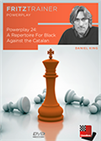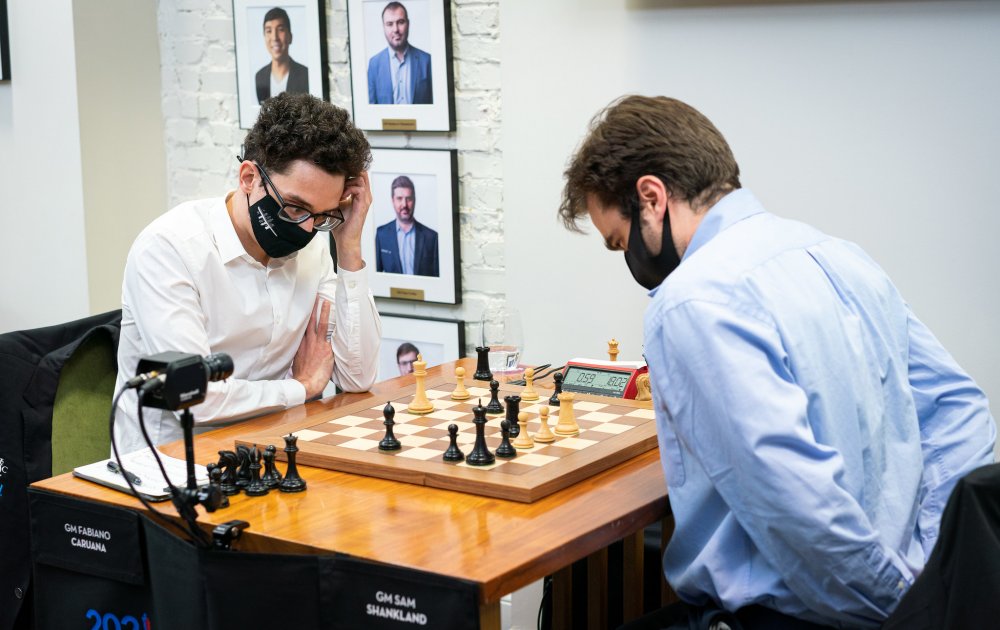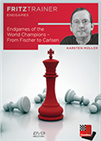A likely outcome
Before the last round of the US Open Championship, Fabiano Caruana, Wesley So and Sam Sevian were tied in the lead with 6 points each. Leinier Dominguez, Aleksandr Lenderman and Ray Robson followed half a point behind. Thus, it was very likely that a playoff would still be necessary to find a winner after the last round.
First, Sevian’s game against Daniel Naroditzky ended in a draw after Sevian, playing with the black pieces, allowed a repetition of moves. Wesley So and Ray Robson quickly found themselves in an even endgame out of a Classical Variation in the Nimzo-Indian Defence, and the point was shared soon after.
 Wesley So published two new opening DVDs: 1.b3, the so called Nimzo-Larsen-Attack, for White and his black secrets in the modern Italian. Get them in a package and save money!
Wesley So published two new opening DVDs: 1.b3, the so called Nimzo-Larsen-Attack, for White and his black secrets in the modern Italian. Get them in a package and save money!
Wesley So

Sam Sevian
With these results, Fabiano Caruana had a chance to become US Champion 2021 by beating Sam Shankland. Caruana had opened the game with the Catalan and reached a comfortable position with a slight initiative. Then, in time trouble, Shankland gave up his queen for a rook and knight and entered a losing position. Caruana, however, failed to convert his advantage into a full point.
White is slightly better with his mobile centre pawns. Black now decided to go for...
34...Qxe5 [A good alternative was 34...c5. But Black had rightly calculated that he had real attacking chances.]
35.dxe5 Rxd3 36.Qa7 Be1 [36...R8d7 37.Qa8+ Kh7 38.Rf2 with the idea Rf4.]
37.Qxb7 Rxg3+ 38.Kh2 Rdd3 The two black rooks in front of the white king look threatening. But White gets the h3-square under control.
39.Qc8+ Kh7 40.Qxe6 Rg6 41.Qf5 Bg3+ 42.Kg2 Bxh4+ 43.Kf1 Re3 Threatening mate.
44.Rc1 c5
45.Rd1? [The only continuation with a chance of winning was 45.e6 Reg3 (45...Rb3 46.Rxc5 Rxb2 47.Re5 Rb7 48.Rxa5+–) 46.Rxc5 R3g5 47.Qf8 Rg1+ 48.Ke2 Rxe6 49.Qf4 Be7 50.Rxa5 Rg2+ 51.Kd3 Reg6 and White still has to work for the win. (51...Rxb2 52.Qf5+) ]
45...c4 46.e6 Reg3 47.Rd7 Rg1+ 48.Ke2 R1g5 49.e7 Leads de facto to a draw. [White can also get into trouble with 49.Qf8 Rg2+ 50.Ke3 Bf2+]
49...Rxf5 50.exf5 Rg1 51.f6 Re1+ 52.Kd2 Re6
 On this DVD Grandmaster Daniel King offers you a repertoire for Black against the Catalan, based around maintaining the rock of a pawn on d5. Keeping central control ultimately gives Black good chances to launch an attack against the enemy king.
On this DVD Grandmaster Daniel King offers you a repertoire for Black against the Catalan, based around maintaining the rock of a pawn on d5. Keeping central control ultimately gives Black good chances to launch an attack against the enemy king.
53.f7 [Another attempt was 53.Rd8 and after 53...Bxf6 54.e8Q Rxe8 55.Rxe8 Bxb2 56.Ra8 both sides still have to be careful: 56...Ba3 57.Kc2 (57.Rxa5? Bb4+) 57...Bb4 58.Rc8 c3 59.Rb8 Be7 (59...h5? 60.Rxb4 axb4 61.a5+–) 60.Rb5 Bd8 61.Rd5=]
53...Bxe7 54.Rxe7 Rf6 55.Kc3 Kg6 56.Kxc4 Rxf7 57.Rxf7 Kxf7 And another pawn endgame appears on the board.
58.b4 Only move, otherwise Black wins. [58.Kb5 is too slow. 58...h5]
58...Ke6 [58...axb4? 59.a5 White gets there first.]
59.b5 The passed pawn secures the draw.
59...Kd6 60.Kd4 h5 61.Ke4 g5 62.Kf5 h4 63.Kg4 Kc5 64.Kh3 Kd6 65.Kg4 Kc5 66.Kh3 Kd6 ½–½

The longest game of the day was produced by Lazaro Bruzon and Alex Lenderman, who discussed a number of fun variations in various endgames.
After a short middlegame, the two grandmasters ended up in this ending.
After the 35th move.
Barely twenty moves later, this position appeared on the board.
 Let endgame expert Dr Karsten Müller show and explain the finesses of the world champions. Although they had different styles each and every one of them played the endgame exceptionally well, so take the opportunity to enjoy and learn from some of the best endgames in the history of chess.
Let endgame expert Dr Karsten Müller show and explain the finesses of the world champions. Although they had different styles each and every one of them played the endgame exceptionally well, so take the opportunity to enjoy and learn from some of the best endgames in the history of chess.
After the 53rd move
Ten moves later, the queens were back on.
White won the a-pawn and tried for more than 60 moves to win the game. But he did not manage to succeed.
There was, however, a victory to report after the round was over. John Burke won quite quickly against Jeffrey Xiong, but not without a bit of luck.
White played 20.Qh4 getting a winning position.
20...c4 [20...Kh7 21.d5 (Or 21.Qf6 Kg8 22.d5 Nd4 23.Nxd4 cxd4 24.e6+–) 21...Nd4 22.Nxd4 cxd4 23.Qf6+–]
21.Nc3 [The right idea, but the wrong execution. White only looks at the square e4 — but f3 also plays a role. The correct execution was 21.Nbd2 Ng5 (21...cxb3 22.Qxh6 d5 23.Re4 dxe4 24.Nxe4 and wins.) 22.Qxh6 Nxf3+ 23.Nxf3 is not enough to defend here.]
21...dxe5 Now the game is lost. [Black could instead defend with 21...Ng5, e.g.: 22.Qxh6 Nxf3+ 23.gxf3 Bxd4]
22.Qxh6 Bc6 23.d5 cxb3 24.Ne4 Qd8 25.dxe6 1–0
Final standings
All games
Links


























